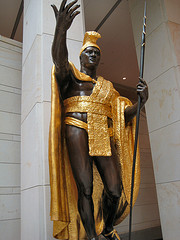Hawaii has a long history before it became a U.S. state in 1959. In fact, the island chain was first settled about two centuries ago by Polynesians traveling by canoe from either Tahiti or from the Marquesas Islands. These early settlers brought pigs, dogs, chickens, coconut, sugarcane, bananas, and taro, each of which would become an integral part of the Hawaiian lifestyle for centuries. Some, like coconut, sugarcane, and bananas, would profoundly impact the physical landscape as well.
The islands of Hawaii were first noticed by Europeans when Captain James Cook happened upon the islands during his search for the Northwest Passage, a water route through North America. Naming the chain the Sandwich Islands, he carried news of his discovery back with him, prompting other Europeans and Americans to settle in the area throughout the 1790s and 1800s. Not only settlers but also missionaries began arriving as soon as 1820, attempting to convert native Hawaiians to Christianity. Within just a few decades, the chain became a primarily Christian nation. Because of all of these foreign influences, the diet and living standards in Hawaii changed significantly during this time.
 At this time, politics within Hawaii were changing rapidly as well. In fact, each Hawaiian island had its own distinct entity as recently as 1810, when King Kamehameha I finally united the islands, forming the Hawaiian Kingdom. A well-developed government was soon established; King Kamehameha III prompted the writing of the Constitution in 1840. By 1848, the government instituted a western-style concept of land ownership, replacing the old system in which the islands were owned in common by every resident. This move, known as Mahele, opened the doors for large pineapple and sugar plantations. As a result, many native Hawaiians were left landless.
At this time, politics within Hawaii were changing rapidly as well. In fact, each Hawaiian island had its own distinct entity as recently as 1810, when King Kamehameha I finally united the islands, forming the Hawaiian Kingdom. A well-developed government was soon established; King Kamehameha III prompted the writing of the Constitution in 1840. By 1848, the government instituted a western-style concept of land ownership, replacing the old system in which the islands were owned in common by every resident. This move, known as Mahele, opened the doors for large pineapple and sugar plantations. As a result, many native Hawaiians were left landless.
In 1843, Hawaii fell briefly under British rule, though the islands regained their sovereignty the same year. Still, this event proved a sign of what was to come. The government of the Kingdom of Hawaii would be challenged throughout the rest of the century, finally being overthrown by American colonists in 1893. Eventually, Hawaii became a U.S. territory in 1898, symbolizing the end of nearly two thousand years of uninterrupted rule by native Hawaiians with Polynesian ancestry.
In December 1941, a surprise attack by the Japanese on Pearl Harbor, Honolulu, resulted in U.S. entry in World War II. Prior to the attack, few Americans had heard of Pearl Harbor in Hawaii, which was then still a U.S. territory. Because of its strategic importance to the U.S. Navy, Hawaii was placed under martial law during the aftermath of this surprise attack. Hawaii was exposed to unprecedented international attention throughout the war, and life would never be as isolated on the islands as it was before the war.
Hawaii became a state in 1959 following a vote showing 94 percent in favor of statehood. Despite this landslide vote, there has always been a significant movement headed by native Hawaiians to regain Hawaiian sovereignty. In fact, various political groups have advocated for self governance in Hawaii since the area became a U.S. territory in 1898.
